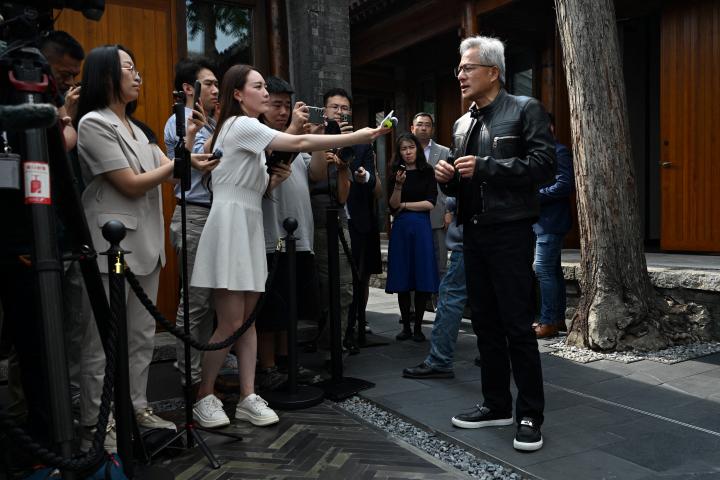
Artificial intelligence is still at the beginning of its growth curve, but both the infrastructure and the valuations behind the boom show signs of strain. For investors, the opportunity is undeniable, yet so are the risks.
Nvidia chief executive Jensen Huang underscored both sides of the story last week. After reporting another quarter of soaring results, he told Wall Street that the real constraint on AI’s growth may not be demand, but electricity.
 Dutch investment strategist Wim Zwanenburg of Stroeve Lemberger shares that view, stressing that investors must prepare for both opportunities and disruption as the technology spreads across sectors.
Dutch investment strategist Wim Zwanenburg of Stroeve Lemberger shares that view, stressing that investors must prepare for both opportunities and disruption as the technology spreads across sectors.
Growth paradox
“We are at the beginning of an industrial revolution that will transform every industry,” Huang told analysts. Nvidia’s datacentre revenue surged 56 percent year-on-year to 46.7 billion dollars. He forecast global spending on AI factories reaching three to four trillion dollars by the end of the decade, underscoring the scale of the bet being placed on artificial intelligence.
Alongside the optimism came a note of caution. “AI factories are power-limited by definition,” Huang admitted. Their performance, and the revenues they generate, depend on the electricity they can secure. The bottleneck is not demand but the capacity of grids, transformers and cooling systems. It is a reminder that this new growth cycle will be shaped as much by infrastructure as by innovation.
“AI factories are power-limited by definition.”
Jensen Huang, Nvidia
Driving the economy
For now, the money pouring into AI is boosting the broader economy. According to the New York Times, companies are on track to spend 375 billion dollars on AI infrastructure in 2025, rising to 500 billion the following year. That investment already accounts for a measurable share of US growth, with software and computer equipment representing a quarter of all economic expansion last quarter.
AI datacentres are not only reshaping markets but also skylines. This year, spending on new datacentres will overtake investment in traditional office buildings. From electricians and engineers to cement producers and equipment suppliers, the boom is lifting a wide swath of the economy. New York-based Brookfield asset management, with over 1,000 billion dollars of assets under management, has invested heavily in the sector and expects AI infrastructure to absorb 7,000 billion dollars globally over the next decade.
The scale of spending has become a rare bright spot for construction and heavy industry as higher rates and tariffs weigh on other sectors. At the same time, its magnitude highlights the importance of execution and sustainability.
Returns still uncertain
Despite the optimism, tangible business returns remain uneven. Hyperscalers have doubled their capital expenditure to 600 billion dollars annually in just two years. Nvidia encourages customers to upgrade every year, moving from Hopper to Blackwell and soon Rubin, each promising efficiency gains. That cycle, while lucrative for suppliers, requires clients to commit to relentless investment before many enterprises have demonstrated measurable benefits.
A study from MIT suggested that 95 percent of corporate AI initiatives had yet to deliver bottom-line benefits within six months. Critics said the sample was small, but the point remains: adoption is still patchy even as the capital cycle accelerates.
Laura Cooper, senior macro strategist at Nuveen, argued that investors should distinguish between revenue growth and sustainable economic returns. “From a demand perspective, it is important to ask the question of whether the current AI-driven capex cycle is delivering sustainable economic returns beyond whether it can deliver revenue growth,” she told Investment Officer. “Our research suggests that we are still in the early innings of the adoption of AI in the ‘enterprise’ segments of the market, suggesting demand will likely be sustained.”
Zwanenburg agrees that short-term returns remain elusive. “Costs come before profits. We are still at the lower end of the S-curve. Revenues are growing exponentially, but at some point growth will taper as the market matures.”
Business models under pressure
Zwanenburg sees opportunities and risks in the shift towards subscription-based revenue models. Many software providers are charging extra for premium AI features, from Adobe to ServiceNow. “Will customers really pay for AI extras when cheaper or even free, advertising-paid alternatives can do the same job?” he asked.
That tension reflects both the promise and the disruption of AI. On one side, incumbents can deepen recurring revenues, on the other, they risk being undercut by open-source challengers.
Past lessons
The speed of the AI build-out has invited comparisons with earlier technology cycles. The fibre-optic boom of the late 1990s saw billions sunk into cables that went dark after the dot-com crash.
“There will be a lot of startups, and many will fail. But network effects and the ability to scale quickly will determine who survives.”
Wim Zwanenburg, Stroeve & Lemberger
Today, analysts warn that a mismatch between capacity and demand could lead to “indigestion” in spending, even if the long-term outlook remains strong.
Still, Zwanenburg does not believe AI is a bubble. “There will be a lot of startups, and many will fail. But network effects and the ability to scale quickly will determine who survives.”
Winners and losers
Nvidia remains the poster child of the AI build-out. Eighty Wall Street analysts cover the stock: seventy recommend buying, nine say hold and only one recommends selling. The company is also repurchasing shares, which provides a modest boost to earnings per share, but the main driver is still profit growth.
Microsoft, meanwhile, illustrates the advantage of incumbents that can layer new technologies on top of existing platforms. “They are a super-adapted corporation with the capacity to invest and stay at the forefront,” Zwanenburg said.
Intel shows the other side. Having missed the shift from CPUs to GPUs, it allowed others to capture the market. “They let themselves be overtaken. It shows how quickly the balance can change in technology markets.”
Infrastructure challenge
Constraints are not theoretical. Almost the entire US energy sector is now catering to big tech, which has become the main force pushing up national energy consumption after years of decline. Communities are beginning to resist. In St. Charles, Missouri, the city council has imposed a moratorium on new datacentres over concerns about water contamination.
These frictions underline the need to align AI’s rapid growth with environmental and social considerations. “Electricity consumption is a bottleneck,” Zwanenburg observed.
On valuations, Cooper downplayed near-term risks, noting that the largest tech companies remain self-funding and cash generative. “Spending on IP equipment and software has picked up this year with tech spending boosting US economic growth by around 30 basis points,” she said. “In our view, elevated spending on data centres and other hardware has already boosted, and will continue to support, near-term economic growth and lift long-term US productivity by roughly 15 percent. From a valuation standpoint, gauges do not appear to be a risk right now because six of the seven companies in the Mag7 generate strong free cash flow and are self-funding.”
The internet did not disappear after 2000. It matured, separating durable franchises from speculative excess. Artificial intelligence is likely to follow a similar trajectory. Huang’s forecast of trillions in spending, coupled with his acknowledgment that power supply is the key limit, signals not a looming crash but an industry learning to grow within its constraints.
As Zwanenburg put it: “Only the firms that continually reinvent themselves will keep pace.”
Related articles on Investment Officer:
- The underestimation of artificial intelligence
- New York’s job fallout from AI signals trouble for Europe’s financial sector
- CSSF aims to set benchmark for AI-based supervision in EU